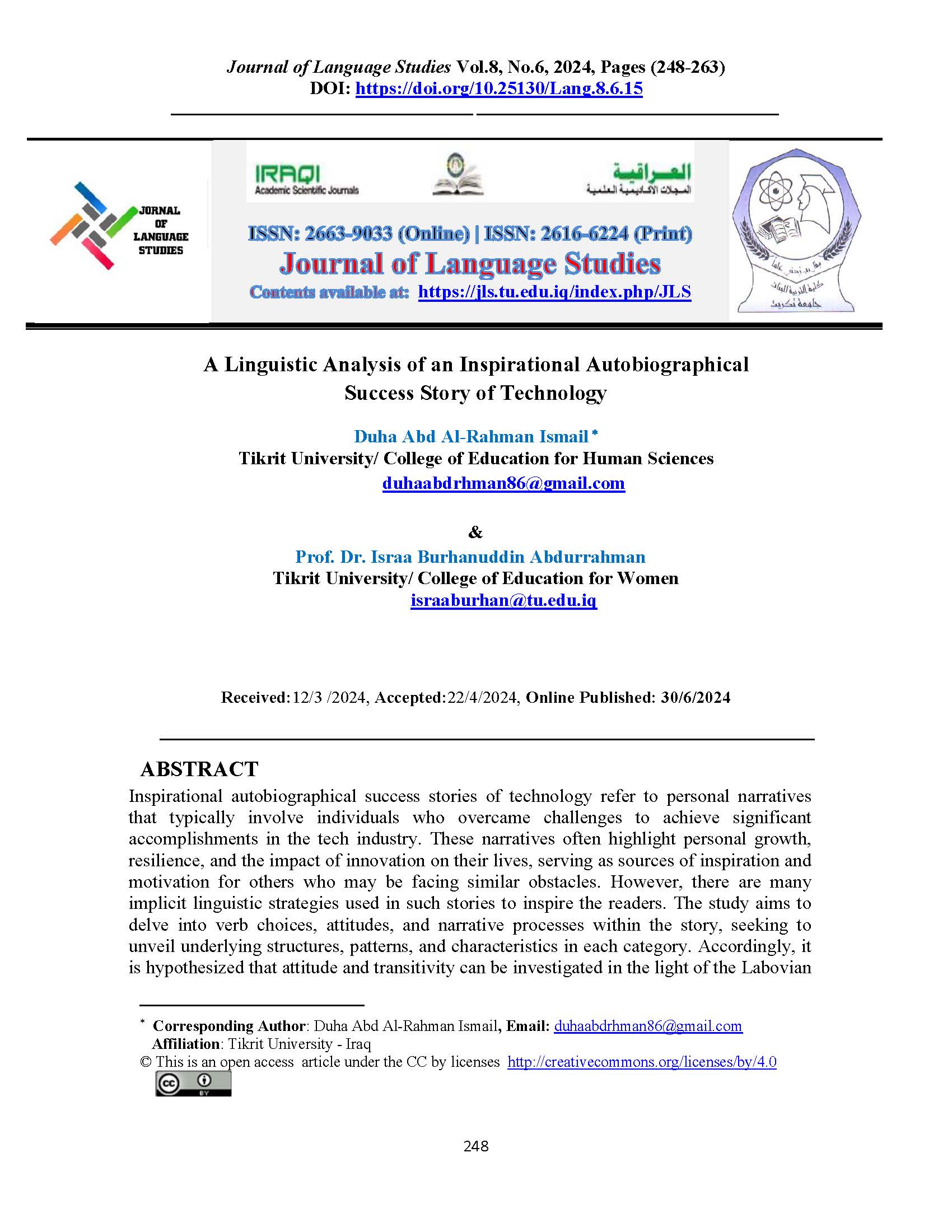A Linguistic Analysis of an Inspirational Autobiographical Success Story of Technology
DOI:
https://doi.org/10.25130/Lang.8.6.15Keywords:
Appraisal Theory, Inspirational Success Stories, Labovian model, TransitivityAbstract
Inspirational autobiographical success stories of technology refer to personal narratives that typically involve individuals who overcame challenges to achieve significant accomplishments in the tech industry. These narratives often highlight personal growth, resilience, and the impact of innovation on their lives, serving as sources of inspiration and motivation for others who may be facing similar obstacles. However, there are many implicit linguistic strategies used in such stories to inspire the readers. The study aims to delve into verb choices, attitudes, and narrative processes within the story, seeking to unveil underlying structures, patterns, and characteristics in each category. Accordingly, it is hypothesized that attitude and transitivity can be investigated in the light of the Labovian structure, and that positive attitude and emotional verb process are the most prevailing in this story. This paper adopts a mixed approach, blending qualitative and quantitative methods by adopting three models of analysis. Drawing upon the narrative analysis model by Labov and Waletzkys (1997), this paper explores the overarching structure of the technology story "love and lose" (2020) by Steve Jobs, including key components such as abstract, orientation, complicating action, evaluation, and resolution. In addition to narrative analysis, this paper incorporates the appraisal theory developed by Martin and White (2005), which focuses on the linguistic choices used to express attitudes, emotions, and evaluations within the narrative. Furthermore, Halliday's transitivity theory (2004) is utilized to explore the linguistic representation by analyzing the transitivity patterns, such as material, mental, and relational processes. The story unfolds as a captivating, authentic narrative with a well-balanced structure, presenting nuanced attitudes that underscore the transformative power in combating technology. The analysis emphasizes a positive and proactive stance, contributing to the overarching goal of inspiring hope and fostering understanding.
References
- Abdurrahman, I. B., Hamad, R. A., Abdurrahman, R. B., Hazim, A. H. A Critical Discourse Analysis of Feminism in Katherine Mansfield's Bliss. Asian Journal of Human Services. (2023) Volume 24, pp. 1–20.
- Abdurrahman, I. B., Hasan, A. Q., Hussein, H. A. A Critical Discourse Analysis of Feminism in Drama: Susan Glaspell and Alice Childress as a Case Study. Asian Journal of Human Services. (2023) Volume 25, pp. 45–66.
- Abdurrahman, I. B., Ecological Discourse Analysis of UNICEF Environmental. Journal of Language Studies. (2023) Vol. 6, No. 3, pp. 16-29.
- Abdurrahman, I. B. Hadi, R. N. Omer, H. K. Investigating the Perception of Multimodal Metaphors by Iraqi EFL Learners. Journal of Tikrit University for Humanities. (2023) 30 (2) 1-35. DOI: http://dx.doi.org/10.25130/jtuh.30.2.1. 2023.23.
- Altier, M. B., Horgan, J., & Thoroughgood, C. In their own words? Methodological considerations in the analysis of terrorist autobiographies. Journal of strategic security, (2012). 5(4), 85-98.
- Bruner, J. Life as narrative. Social Research, (1987). 54, 11-32.
- Gibbs, G. R. Analyzing biographies and narratives: Documentary & archival research. (2014). London: Sage.
- Humphreys, M., Ucbasaran, D., & Lockett, A. Sense making and sense giving stories of jazz leadership. Human Relations, (2012). 65(1), 41-62.
- Mahdi, D. A. and Abdurrahman, I. B. A Pragmatic Study of School Bullying in Wonder Movie. Asian Journal of Human Services. (2027) Volume 26, 1-18. DOI: http://dx.doi.org/10.14391/ajhs.26.1
- McLellan, H., Introduction to corporate storytelling. 2002. [Online] Available: www.tech-head.com/cstory1.htm.
- Reamy, T., Imparting knowledge through storytelling. KM World, 2002. 11(7). [Online] Available: www.kmworld.com.
- Reveley, J. Using autobiographies in business history: A narratological analysis of Jules Joubert’s shavings and scrapes. Australian Economic History Review, (2010). 50(3), 284-305.
- Smith, S., & Watson, J. Reading autobiography: A guide for interpreting life narratives. (2010). London: University of Minnesota Press.
- Stein, N. L. The definition of a story. Journal of pragmatics, (1982). 6(5-6), 487-507.

